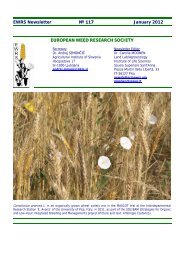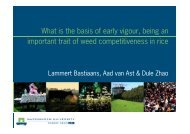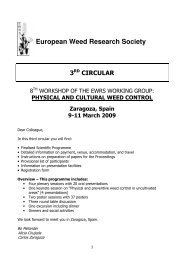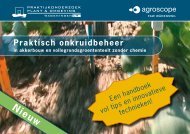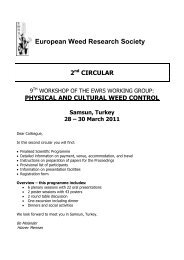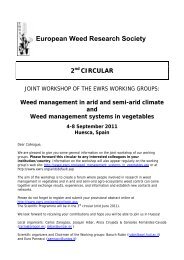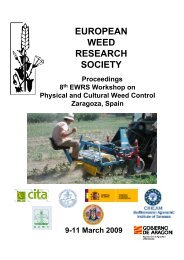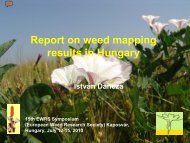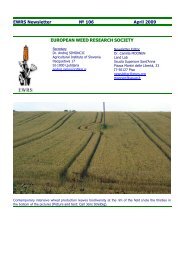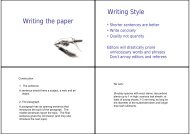Physical and Cultural Weed Control Working Group of - European ...
Physical and Cultural Weed Control Working Group of - European ...
Physical and Cultural Weed Control Working Group of - European ...
Create successful ePaper yourself
Turn your PDF publications into a flip-book with our unique Google optimized e-Paper software.
9 th EWRS Workshop on <strong>Physical</strong> <strong>and</strong> <strong>Cultural</strong> <strong>Weed</strong> <strong>Control</strong> 36<br />
Samsun, Turkey, 28 – 30 March 2011<br />
<strong>Control</strong> treatment without Velvet leaf sesame leaf area index was significantly increased 12<br />
plants m −2 Velvet leaf, sesame leaf area index less than 53 percent without Velvet leaf control<br />
treatment were recorded. Sesame average LAI in treatments 0, 4, 8 <strong>and</strong> 12 plants m −2 respectively<br />
1.51, 0.88, 0.72 <strong>and</strong> 0.71 respectively (Table). Probably by increasing competition between species<br />
density Velvet leaf stronger <strong>and</strong> one <strong>of</strong> the factors in this competition, increasing weed leaf area<br />
index compared to sesame has been able maximum efficiency <strong>of</strong> light sources to increase LAI to<br />
create <strong>and</strong> decreases LAI is sesame. Sadeghi et al. (2002 <strong>and</strong> 2003) also found that leaf area index<br />
greater impact on weed dry weight loss products <strong>and</strong> therefore have more competitive power will be<br />
more soybeans. Probably by increasing plant population density <strong>of</strong> the final leaf area index per unit<br />
area is increased if Morrison et al. (1990) stated that in the same plants that grow in less space, the<br />
amount <strong>of</strong> dry matter per unit area <strong>and</strong> length <strong>of</strong> their growing larger <strong>and</strong> thus had greater LAI.<br />
Main stem diameter: maximum diameter <strong>of</strong> the treated sesame shoot without Velvet leaf weeds<br />
were recorded. The density <strong>of</strong> 12 plants per square meter Velvet leaf, 27 percent <strong>of</strong> Sesame stem<br />
diameter less than the control treatment showed no weed. Average stem diameter in treated sesame<br />
zero, four, eight <strong>and</strong> 12 plants m −2 respectively 7.11, 5.99, 5.25 <strong>and</strong> 5.18 mm, respectively (Table).<br />
Appears to increase competition <strong>and</strong> interaction between species, has been able Velvet leaf its<br />
negative effects on the main stem diameter Sesame to create <strong>and</strong> cause weakening in these traits are<br />
treatments. Abdollahi <strong>and</strong> Bararpoor (2007) showed that the densities <strong>of</strong> the soybean cultivar<br />
Williams Velvet leaf density 0.25 Velvet leaf m row soybean plant, stem diameter compared to 11<br />
percent weed-free treatment reduced these results show that the competitive power Velvet leaf<br />
much weed. Kim <strong>and</strong> Moody (1980) as they also increase the density <strong>of</strong> rice stem thickness is<br />
reduced.<br />
Branch number: 100 kg treated ha increased 15 percent from the branch number 3.69 in<br />
treatment number 50 kg ha −1 to 4.36 quarters were branch number (Table). Number <strong>of</strong> branches,<br />
one <strong>of</strong> the important performance characteristics are increasing nitrogen has shown a positive<br />
response. Paparimoghaddamfard (2000) reported nitrogen fertilizer quite significant impact on crop<br />
characteristics such as number <strong>of</strong> branches per plant is sesame. In weed control treatment without<br />
Velvet leaf most number <strong>of</strong> branches <strong>and</strong> sesame were caused in 12 plant density Velvet leaf<br />
Sesame branch number to 27 percent rate with no weed control treatment decreased. Average<br />
number <strong>of</strong> branches in the treated sesame seeds0, 4, 8 <strong>and</strong> 12 plants m −2 respectively 4.83, 4.17,<br />
3.59 <strong>and</strong> 3.51 the number (Table). Any increase in space to form a sub-category with the lowest<br />
Sesame competitive conditions <strong>and</strong> vice versa, the number <strong>of</strong> branches <strong>of</strong> positive <strong>and</strong> negative<br />
effects <strong>of</strong> sesame has established itself. Sadeghi et al. (2002 <strong>and</strong> 2003) found that in determining the<br />
share <strong>of</strong> each <strong>of</strong> the attributes <strong>of</strong> soybean in the ability to compete with weeds, whatever the number<br />
<strong>of</strong> branches is higher, more effective on weight loss, dry weeds have <strong>and</strong> thus the power <strong>of</strong><br />
competition more weeds will be more. Kim <strong>and</strong> Moody (1980) <strong>and</strong> Alhani (2006) showed that<br />
increasing plant population density reduced the number <strong>of</strong> secondary branches.The final dry aerial:<br />
Most final dry weight in sesame without weed control treatment was Velvet leaf. Any Velvet leaf<br />
weed density increased final dry weight also decreased sesame; If Velvet leaf at 12 plants m −2<br />
decreased 20 percent compared to sesame final dry weight with no weed control treatment was.<br />
Average dry weight in the final treatment Sesame 0, 4, 8 <strong>and</strong> 12 plants m respectively in 2969,<br />
2769, 2470 <strong>and</strong> 2378 kg ha −1 respectively (Table). Sadeghi et al. (2002 <strong>and</strong> 2003) found that in<br />
determining the share <strong>of</strong> each <strong>of</strong> the attributes <strong>of</strong> soybean in the ability to compete with weeds,<br />
whatever the total amount <strong>of</strong> dry matter is higher, more effective on weight loss, dry weeds have<br />
<strong>and</strong> thus the power <strong>of</strong> competition more weeds will be more. Andy <strong>and</strong> Larry (1997) also showed<br />
the impact <strong>of</strong> weeds on crop canopy <strong>and</strong> associated products increased with was Increasing canopy<br />
biomass <strong>and</strong> successfully compete.Hagood et al. (1980) in a study reported that the density <strong>of</strong> 2.4<br />
to 40 plants m −2 Velvet leaf decrease in dry weight final.Abdollahi <strong>and</strong> Bararpoor (2007) also<br />
showed that the effect <strong>of</strong> density on growth <strong>and</strong> yield Velvet leaf soybean cultivar Williams, density<br />
0.25 Velvet leaf plant dry weight in soybean respectively, 6.4 percent compared with weed-free<br />
treatment to reduce said.



